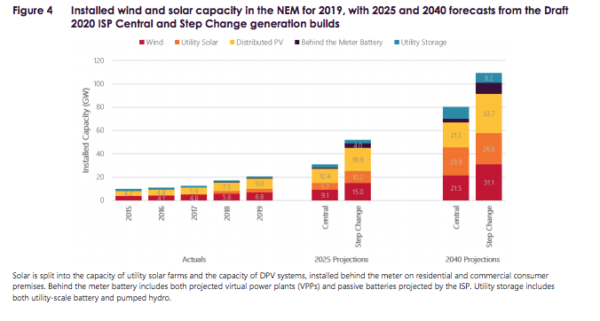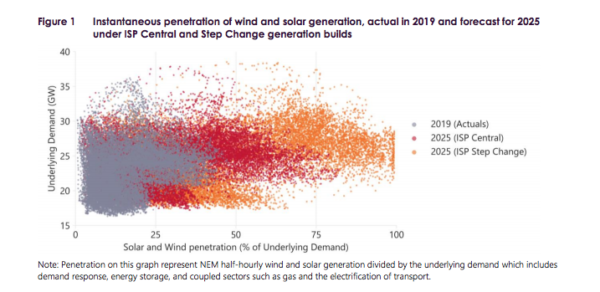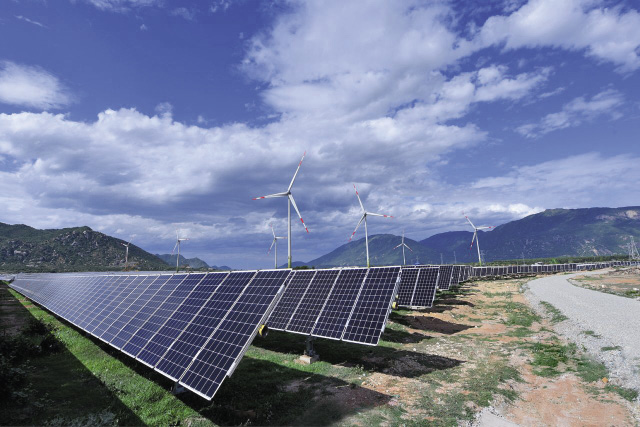Australia’s main electricity grid can safely accommodate up to 75% renewable energy as soon as 2025, the Australian Energy Market Operator (AEMO) finds in a new study. However, such a huge jump in solar and wind power on the grid is possible only if market and regulatory arrangements are changed.
On Thursday, AEMO released the much-anticipated Renewable Integration Study (RIS), the first stage of a multi-year plan to maintain system security in a future National Electricity Market (NEM) with a high share of renewable resources. This report takes the projections from AEMO’s 20-year grid transition blueprint, the Integrated System Plan, and confirms that the grid is already capable of handling a very high penetration of intermittent renewables.
“Australia has the technical capability to operate a power system where three-quarters of our energy at times comes from renewable energy resources,” Audrey Zibelman, AEMO’s Managing Director and CEO, said. “However, to do so requires changes in our markets and regulatory requirements, otherwise, AEMO will be required to limit the contribution of these wind and solar resources to 50 or 60% of electricity supply at any point in time, even though they are the lowest cost way of providing electricity.”
The share of renewable energy in the National Electricity Market (NEM) has been at around 25% in recent months and has occasionally for brief periods exceeded 50%, most recently on Easter Saturday. In total, the NEM has 17 GW of wind and solar generation capacity, according to AEMO data, with several regions among the world’s highest levels of wind and solar, including one of the highest levels of residential PV.

By 2025, AEMO’s Draft 2020 ISP forecasts in its ‘central’ scenario that this can increase to 27 GW of wind and solar, including both utility and distributed solar PV. But as the NEM continues its transformation, the latest study makes it clear that “today’s operating approaches and market frameworks are becoming less effective,” Zibelman underlines.
“Given the pace and complexity of change in the NEM, the study highlights the need for flexible market and regulatory frameworks that can adapt swiftly and effectively as our understanding of the changing power system evolves. This is going to be particularly important in the areas of technical standards and frameworks for sourcing essential system services,” she said.
Challenges and recommended actions
Although the new report builds on international approaches to operating power systems with high penetrations of wind and solar generation, it recognizes Australia’s unique challenges, such as network congestion, system curtailment, and participant spill (which happens when renewable generation removes itself from the market (self-curtails) due to market signals). The RIS comes hot on the heels of a major feat for the energy sector, which has seen AEMO lift generation constraints imposed on five solar farms in the West Murray Zone, following successful testing of new tuned inverter settings.
Looking at a broader picture, the RIS focuses on the impact of wind and solar instantaneous penetration in the NEM power system. Specifically, limits that affect how much wind and solar PV generation can operate at any one time, and what the limits are NEM-wide and for individual regions; how close NEM regions are to these limits now, and how close they are expected to be by 2025; and actions that can overcome these barriers.

Based on the learnings contained in the RIS, AEMO recommends the following actions are prioritized, agreed, and implemented well ahead of 2025:
- Continue the design and deployment of the Energy Security Board’s (ESB) Market 2025 reform program with particular focus on ahead and system security services markets. As part of the program, the ESB is assessing market mechanisms that increase certainty around system dispatch of energy and essential system services (inertia, system strength, minimum synchronous units, operating reserves, and flexibility) as real-time approaches. The ESB will recommend a high-level design to the COAG Energy Council by end of 2020 for implementation by 2025.
- New standards and settings to maximize the potential contribution of distributed solar PV. In collaboration with industry, through the Standards Australia committee, AEMO is seeking to progress update to the national standard for inverters (AS/NZS4777.2) to incorporate bulk system disturbance withstand and autonomous grid support capability. This echoes the finding of the recently released DER Roadmap in Western Australia, which is recommending the implementation of a distribution-network visibility program, to enhance understanding of power flows and constraints; and SWIS-specific autonomous inverter settings will be enabled to provide better performance during disturbances to the grid.
- Construction of required transmission resources identified in the ISP
In recommending actions and highlighting positive potential outcomes, AEMO does not underestimate the extent of work that will be required to successfully adapt the NEM. Finally, the report concludes that “beyond 2025, AEMO has not identified any insurmountable reasons why the NEM cannot operate securely at even higher levels of wind and solar penetration, especially with ongoing technological advancement worldwide”.
“The findings of this report have far-reaching implications for the energy sector in Australia now and in the coming years,” Zibelman said. “AEMO looks forward to working closely with stakeholders to explore the findings and actions arising from this report and develop an integrated program of priority focus areas to support the energy transition.”
In a statement on Thursday, Energy and Emissions Reduction Minister Angus Taylor said the report highlighted the challenges of integrating record amounts of renewable energy into the grid. Not surprisingly, Taylor’s interpretation of AEMO’s findings boiled down to another call for more gas generation in the NEM.
“The AEMO study recognises solar and wind generation alone aren’t enough, minimum levels of inertia that is ordinarily provided by synchronous generation – such as a gas-fired power station – will be crucial to maintaining the security of any large power system,” he said.
Last week, Taylor suggested the Government is bent on investing in gas projects to provide more “cheap energy” to the market to help lead recovery from the Covid-19 crisis.
This content is protected by copyright and may not be reused. If you want to cooperate with us and would like to reuse some of our content, please contact: editors@pv-magazine.com.









4 comments
By submitting this form you agree to pv magazine using your data for the purposes of publishing your comment.
Your personal data will only be disclosed or otherwise transmitted to third parties for the purposes of spam filtering or if this is necessary for technical maintenance of the website. Any other transfer to third parties will not take place unless this is justified on the basis of applicable data protection regulations or if pv magazine is legally obliged to do so.
You may revoke this consent at any time with effect for the future, in which case your personal data will be deleted immediately. Otherwise, your data will be deleted if pv magazine has processed your request or the purpose of data storage is fulfilled.
Further information on data privacy can be found in our Data Protection Policy.